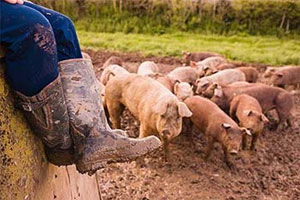A New Twist for Ebola: Reston-Infected Pigs in the Philippines
Posted January 5, 2009 by Ali S. Khan

Ebola-Reston [initial identification] virus is a mystery. Although quite deadly in monkeys, this Ebola cousin doesn’t appear to cause human illness. And who knows how it got to or independently evolved in the Philippines – a good 7,000 miles and really big ocean away from its Zaire, Sudan, Cote D’Ivoire, and Bundibugyo brethren in Africa. If that wasn’t enough, our colleagues at Plum Island recently suspected it as the cause of disease in some sick pigs for the first time from the Philippines that happened to be submitted for testing for Porcine Reproductive and Respiratory Syndrome (PRRS).
CDC’s chief viral special pathogens expert and Chief Pathologist assisted the USDA in confirming the diagnosis amongst multiple pig samples, including virus isolation, from 3 separate farms and sharing the results with both the human and animal health authorities in the Philippines.
According to officials at the Philippines' Bureau of Animal Industry, pig farmers in three provinces near the capital of Manila began noticing high rates of sickness and death among their livestock as early as May. Philippine authorities have said that they have quarantined affected farms, canceled plans for the country's first official exports of pork, and conducted tests on hog farmers and slaughterhouse workers without evidence of human infection.
We are working with the Paris-based World Organization for Animal Health, known by its French acronym OIE, FAO, and WHO to assist in a local investigation in mid-January. Dr. Pierre Rollin will be participating with these groups to assist the Ministry of Health in an animal and human health assessment. Right now, we think the reservoir of Ebola-Reston virus is a frugivorous bat (although we don't have the proof for Reston virus, it is the case for Ebola, Zaire and Marburg, other viruses from the same family) making it very difficult or impossible to get rid of it. Understanding the ecologic situation that led to this outbreak will go a long way to help us understand a little bit more about this virus and its deadlier cousins.
Comments
No comments posted.
Disclaimer: The content of Public Health Matters expresses the opinions of its authors and does not necessarily represent the views of the Centers for Disease Control and Prevention.
- Page last reviewed: January 5, 2009
- Page last updated: January 15, 2009
- Content source: National Center for Zoonotic, Vector-Borne, and Enteric Diseases
Get email updates
To receive email updates about this page, enter your email address:
Contact Us:
- Centers for Disease Control and Prevention
1600 Clifton Rd
Atlanta, GA 30333 - 800-CDC-INFO
(800-232-4636)
TTY: (888) 232-6348
24 Hours/Every Day - cdcinfo@cdc.gov


